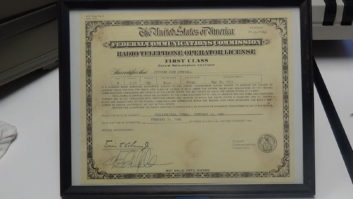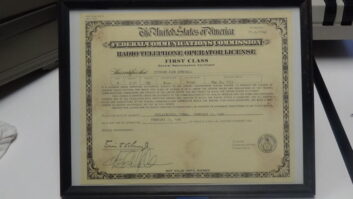
Milford Smith is vice president, radio engineering, Greater Media. This is one in a series of Q&As with industry professionals about their presentations at the upcoming NAB Show in Las Vegas.
Radio World: You have assembled an all-star lineup for the Radio Technology Forum, Sunday, April 12, starting at 1 p.m., including this year’s Radio Engineering Achievement Award winner Tom King. It runs the gamut in subject matter as well, from smartphones to digital radio to cutting edge routing, it looks like radio is a hotbed of technological and engineering research.
Milford Smith: That is a correct statement. In addition to chairing this session, I was also fortunate enough to serve on the BEC conference planning committee, the group that solicits, reviews and selects the papers for the various sessions. Having served on this committee numerous times in the past, I can honestly say that the quality and focus of the papers submitted and ultimately selected this year are among the best in recent memory. I would surely encourage attendees to catch as many of these BEC sessions as possible, especially the Sunday sessions which do not compete with the floor.
RW: Digital technologies, HD Radio and AM digital, etc., are a lightning rod (at least for some) yet you’ve got three sessions, “-10 dB IBOC at Combined Transmission Sites,” “Field Trial Results of AM Transmitter Carrier Synchronization” and “IBOC Broadcast Systems Architecture Technology Options and Assessment,” on the topic. Tell us why digital is a solution or why a station/station owner/engineer should pay attention to these sessions?
Smith: After a long and difficult gestation period, OEM auto manufacturers are now fully onboard with HD Radio and the number of vehicles so equipped is increasing exponentially with virtually every manufacturer now committed. Any broadcaster who was hesitant to embrace HD Radio due to a perceived lack of receivers needs to reexamine their stance. The three sessions noted deal with very different topics but all are pertinent to those employing or considering HD Radio technology. In “-10 dB IBOC at Combined Transmission Sites,” John Schadler of Dielectric addresses the not-so-obvious results of combining multiple high-power digital signals into a common transmission system. There are definitely some things to be aware of when entering into such a situation.

In the paper “Field Trials of AM Transmitter Carrier Synchronization,” Dr. Steve Smith presents for the first time hard data on the results of “locking” nearby co-channel AM carriers to a GPS for exact frequency synchronization. Significant improvements in co-channel interference are claimed. In “IBOC Broadcast Systems Architecture Technology Options and Assessment,” Philip Schmid of Nautel discusses the rapidly evolving technology of HD Radio, particularly improvements in the current generation of importers, exporters and exciters both as to the evolution in the physical architecture as well as significant electronic improvements in both reliability and over all transmitter efficiency.
RW: AES67 just recently got onto the radar of a lot of people. It looks to have moved out of the experimental stage to actually being available. Why should busy engineers need to take time out of their busy show schedules and listen to Andreas Hildebrand in “Rolling Out AES67 Into Real-World Applications”?
Smith: AES67 is really the first “official” standard published dealing with high-performance streaming audio over IP. As such it has the potential to ultimately become “the standard” for much of the AoIP world, thus potentially insuring interoperability among systems which currently are all somewhat proprietary. With the rapid acceptance and deployment of AOIP in the studio plant, with hundreds, if not thousands, of such installations already in place, knowledge of AES67 and the realities of the impact of its ultimate deployment in real-world situations will be extremely valuable to those involved or about to be involved in dealing with AoIP installations.
RW: It’s no secret that being a broadcast engineer increasingly feels like being an IT engineer. You arranged a whole session on Ethernet switches, “Stranger in a (Very) Strange Land: Ethernet Switches in Your IP Audio Network, What You Need to Know.” Will we be seeing more of that?
Smith: If AM directional antennas are considered as “black magic” on the transmission side, Ethernet switches are sometimes seen in the same light on the IT/AoIP side. Typically they exist as “black boxes,” initially configured by a system guru and left to do their critical job until something goes wrong or an upgrade is necessary. In the meantime, many of us are uneasy about the presence of such a “stranger” in our midst, especially one that is so critical to the entire AoIP plant. Dave Breithaupt from Wheatstone will attempt to demystify these devices, give real world examples of their set-up and use in a broadcast plant and finally attempt to answer the question of who — the audio guys or the IT guys — should be tasked with looking after these devices? This should be a great session. Ethernet switches are the core component of any AoIP plant and the opportunity to achieve a better understanding of same certainly something of which to take advantage.
RW: Tom King and Steve Smith are doing double duty for you. Are they crazy with their AM receiver improvement campaign or are they onto something in their session, “Smart AM Receivers for the 21st Century”?
Smith: Tom King, this year’s NAB Radio Engineering Achievement Award winner, and Steve Smith are both among the few true gurus of AM transmission systems. I have known Tom for what seems like forever and I have the utmost respect for his and Steve’s expertise. There is no doubt that better AM receivers would be very welcome to the broadcast and, especially, the listening community. Although there are myriad reasons for the perceived “decline of AM,” less-than-stellar receiver performance, particularly in regard to inference rejection and frequency response, parameters not independent of one another, is certainly one important factor. To turn the nearly ubiquitous tide of relatively unsophisticated, narrow-band receivers will be quite a challenge but Tom has formulated a plan to attempt to do so and I believe it deserves consideration.
RW: There are a lot more papers than what we’ve discussed here, give us an intriguing session that you are looking forward to.
Smith: I always look forward to any sessions on audio processing and we have a very good one this year. Cornelius Gould of The Telos Alliance, one of the “next generation” of talented audio processing designers, comes at this topic from a very different direction. His paper is entitled “Processing Smarter, Not Harder, for Today’s Ratings Wars,” which is surely not the usual louder, brighter, denser approach. His watchword is that in a PPM world one needs to process not only for a station’s signature sound but also to take into account the realities of the PPM encoding process in the design and setup of a station’s processing chain. He will be presenting results of lab and field testing and then formulate some recommendations as to how to best accomplish both goals.











